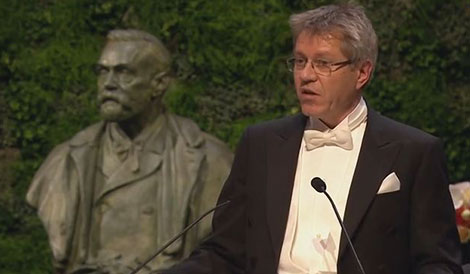Award ceremony speech
English
Presentation Speech by Professor Ole Kiehn, Member of the Nobel Assembly at Karolinska Institutet, Member of the Nobel Committee for Physiology or Medicine, 10 December 2014

Professor Ole Kiehn delivering the Presentation Speech for the 2014 Nobel Prize in Physiology or Medicine at the Stockholm Concert Hall.
Your Majesties, Your Royal Highnesses, Esteemed Laureates, Ladies and Gentlemen,
We do it every day. Many times a day. You did it when you came to this Nobel Prize Ceremony: you found your way! And when you entered the room and sat down, you immediately knew where you were and got a sense of the place. Should you come here again, you will know that this is the Stockholm Concert Hall and not any other concert hall in the world. The ability to orient in space, to find our way, and to remember places that we have visited is necessary to survive, both for animals and human beings. For this to happen, we need our brain and our “inner GPS”.
But where in the brain is the positioning system, the inner GPS, located? And how can nerve cells code such abstract mental activities? The work of this year’s Nobel Laureates in Physiology or Medicine has given us answers to these fundamental questions, which are among the greatest in neuroscience.
In the late 1960s, John O’Keefe performed experiments in rats that were moving freely around. While they were doing that, he recorded from nerve cells in a structure deep inside the brain, called the hippocampus. Here he discovered cells that were active only when the rat was in a specific location in the environment. When it moved to other places, new cells were active. He called these cells “place cells”. The place cells report the position of the rat and build up an inner map that represents a mental picture of the environment. O’Keefe suggested that memory of a place may be stored as a specific combination of place cell activities. By these groundbreaking experiments, O’Keefe showed how specialised nerve cells encode an awareness of space, so that familiar, as well as unfamiliar environments may be recognised.
More than thirty years after O’Keefe’s discovery, May-Britt Moser and Edvard Moser discovered an amazing pattern of nerve cell activity in a brain region near the hippocampus, called the entorhinal cortex. Here certain cells, which they named “grid cells”, were active when the rat was at several places. When a grid cell was active, its activity formed a hexagonal grid pattern in the environment. The Mosers showed that this hexagonal pattern was not imported from the environment but generated entirely by activity in the brain. The activity of many grid cells provides the brain with a coordinate system that divides the environment into longitudes and latitudes and allows us to keep track of how far we are from a starting point as we navigate our environment. The Mosers groundbreaking discovery showed that the brain holds a mental representation of a coordinate system that can be used to find the way in the external world.
Continued research showed that grid cells, together with other types of cells of the entorhinal cortex, form a circuitry with place cells in the hippocampus. Together, this nerve cell circuitry constitutes a positioning system in the brain, an inner GPS.
Today we know that humans also have place cells and grid cells similar to the ones found in rats. Your place cells and grid cells may have made it possible for you to find your way here tonight, to have an awareness of where you are in this magnificent Hall, and recognise it should you come back. Without these cells you could easily get lost in space.
Professors John O’Keefe, May-Britt Moser and Edvard Moser:
The discovery of the place and grid cells, key elements in the brain’s positioning system, is a paradigm shift in our understanding of how groups of specialised nerve cells work together to execute higher brain functions. Through brilliant experiments, you have given us new insight into one of the greatest mysteries of life: how the brain creates behaviour and provides us with fascinating mental proficiencies.
On behalf of the Nobel Assembly at Karolinska Institutet, I wish to convey to you our warmest congratulations. May I now ask you to step forward to receive the Nobel Prize from the hands of His Majesty the King.
Nobel Prizes and laureates
Six prizes were awarded for achievements that have conferred the greatest benefit to humankind. The 12 laureates' work and discoveries range from proteins' structures and machine learning to fighting for a world free of nuclear weapons.
See them all presented here.
